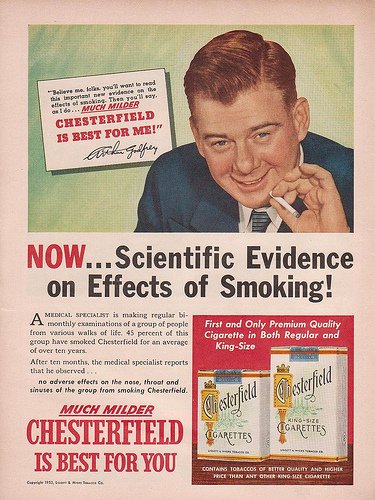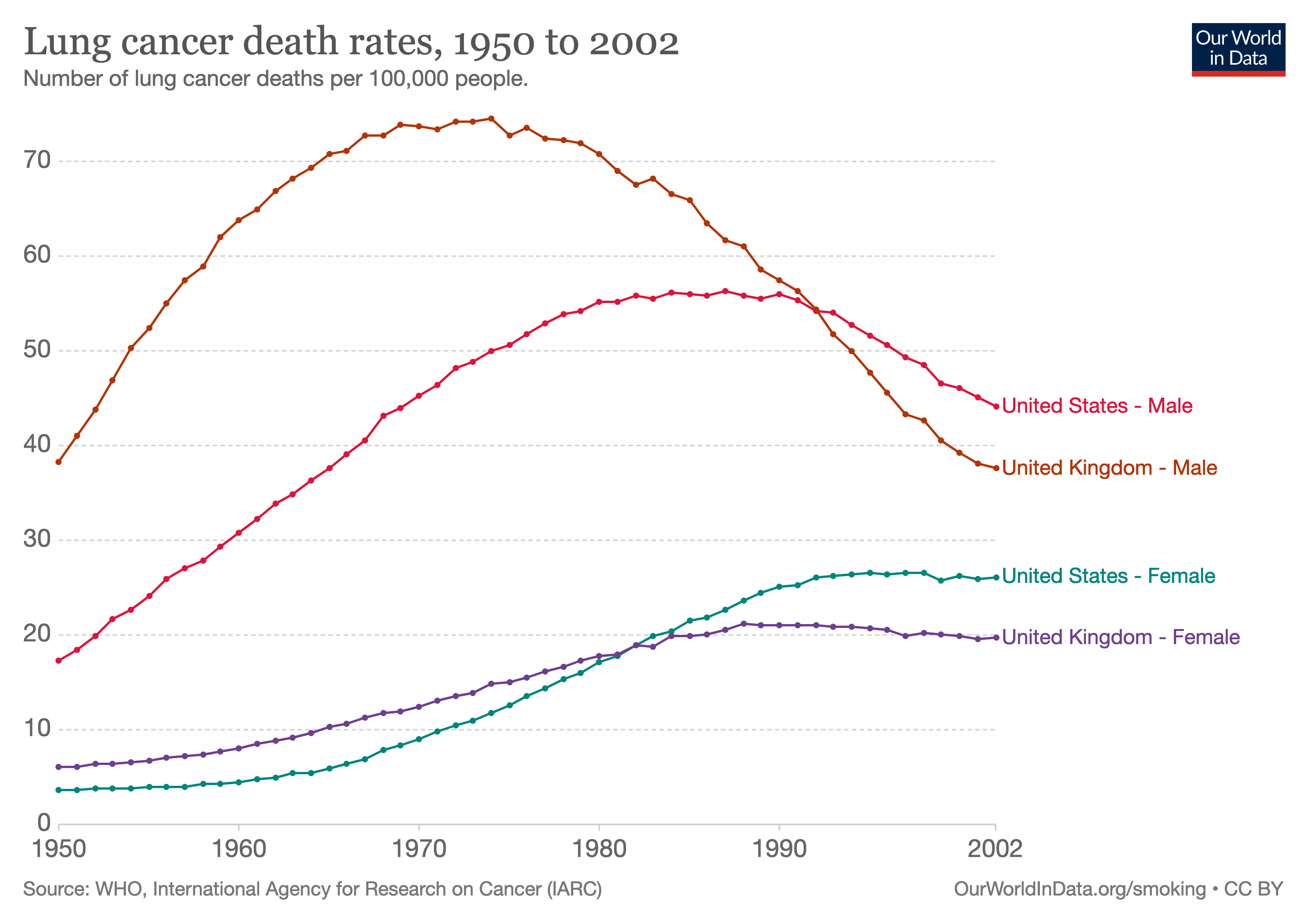class: right, top, title-slide .title[ # Machine learning ] .subtitle[ ## Interpreting regression and causality ] .author[ ### Joshua Loftus ] --- class: inverse <style type="text/css"> .remark-slide-content { font-size: 1.2rem; padding: 1em 4em 1em 4em; } </style> ### From the stars to "Poor Law Statistics" - Almost a century after Gauss - Scientists correlating/regressing anything - Problem: what does it mean? e.g. [Francis Galton](https://www.theguardian.com/education/2020/jun/19/ucl-renames-three-facilities-that-honoured-prominent-eugenicists) correlated numeric traits between generations of organisms... But *why*? "[Nature versus nurture](https://en.wikipedia.org/wiki/Nature_versus_nurture)" debate (still unresolved?) e.g. [Udny Yule](https://en.wikipedia.org/wiki/Udny_Yule) and others correlated poverty ("pauperism") with welfare ("out-relief")... But *why*? "[Welfare](http://economistjourney.blogspot.com/2014/08/the-crazy-dream-of-george-udny-yule-is.html) [trap](https://en.wikipedia.org/wiki/Welfare_trap)" debate (still unresolved?) --- class: inverse # Origin of multiple regression .pull-left[ - Udny Yule (1871-1951) - Studied this poverty question - First paper using multiple regression in 1897 - Association between poverty and welfare while "controlling for" age ] .pull-right[  ] --- class: inverse ## Yule, in 1897: > Instead of speaking of "causal relation," ... we will use the terms "correlation," ... - Variables, roughly: - `\(Y =\)` prevalence of poverty - `\(X_1 =\)` generosity of welfare policy - `\(X_2 =\)` age - Positive correlations: - `\(\text{cor}(Y, X_1) > 0\)` - `\(\text{cor}(X_2, X_1) > 0\)` Do more people enter/stay in poverty if welfare is more generous? Or is this association "due to" age? --- class: inverse ## Yule, in 1897: > The investigation of **causal relations** between economic phenomena presents many problems of peculiar difficulty, and offers many opportunities for fallacious conclusions. > Since the statistician can seldom or never make experiments for himself, he has to accept the data of daily experience, and *discuss as best he can the relations of a whole group of changes*; he **cannot, like the physicist, narrow down the issue to the effect of one variation at a time. The problems of statistics are in this sense far more complex than the problems of physics**. --- class: center, middle # [We] cannot [...] narrow down the issue to the effect of **one variation at a time** -- but... isn't this how *almost everyone* interprets regression coefficients?... # 🤔 🤨 (yes! and they are wrong!!!!) --- class: middle Warning: don't go this way the next slide is about some common mistakes people make when interpreting regression coefficients (don't try to memorize the formulas) --- ### Interpreting regression coefficients People *want* these things to be true: - "The linear **model** and our **estimates** are both good" `$$\frac{\partial}{\partial x_j} \mathbb E[\mathbf y | \mathbf X] = \beta_j \approx \hat \beta_j$$` - "We can interpret `\(\beta_j\)` as a causal parameter," i.e. **intervening** to increase `\(x_j\)` by 1 unit would result in conditional average of `\(y\)` changing by `\(\beta_j\)` units $$ \text{If } (x_j \mapsto x_j + 1) \text{ then } (\mathbb E[y] \mapsto \mathbb E[\mathbf y | \mathbf X] + \hat \beta_j) $$ ## But this *almost never* works! --- Many textbooks tell us something like: > "The coefficient `\(\hat \beta_j\)` estimates the relationship between the (conditional mean of the) outcome variable and `\(x_j\)` *while holding all other predictors constant*" i.e. "**ceteris paribus**" or "other things equal" (unchanged) #### Fundamental problem of interpreting regression coefficients: -- "holding all other predictors constant" is (almost) never applicable in the real world, i.e. ceteris is (almost) never paribus Reasons we'll highlight today: **causality** and **nonlinearity** --- ## Interpreting causality Back to Yule. What does `\(\hat \beta_\text{welfare}\)` mean? .panelset[ .panel[.panel-name[Poverty] ```r lm(poverty ~ welfare + age) |> broom::tidy() |> knitr::kable() ``` <table> <thead> <tr> <th style="text-align:left;"> term </th> <th style="text-align:right;"> estimate </th> <th style="text-align:right;"> std.error </th> <th style="text-align:right;"> statistic </th> <th style="text-align:right;"> p.value </th> </tr> </thead> <tbody> <tr> <td style="text-align:left;"> (Intercept) </td> <td style="text-align:right;"> -0.009 </td> <td style="text-align:right;"> 0.046 </td> <td style="text-align:right;"> -0.19 </td> <td style="text-align:right;"> 0.849 </td> </tr> <tr> <td style="text-align:left;"> welfare </td> <td style="text-align:right;"> 0.491 </td> <td style="text-align:right;"> 0.015 </td> <td style="text-align:right;"> 31.97 </td> <td style="text-align:right;"> 0.000 </td> </tr> <tr> <td style="text-align:left;"> age </td> <td style="text-align:right;"> 0.267 </td> <td style="text-align:right;"> 0.083 </td> <td style="text-align:right;"> 3.21 </td> <td style="text-align:right;"> 0.001 </td> </tr> </tbody> </table> ] .panel[.panel-name[Welfare] ```r lm(welfare ~ poverty + age) |> broom::tidy() |> knitr::kable() ``` <table> <thead> <tr> <th style="text-align:left;"> term </th> <th style="text-align:right;"> estimate </th> <th style="text-align:right;"> std.error </th> <th style="text-align:right;"> statistic </th> <th style="text-align:right;"> p.value </th> </tr> </thead> <tbody> <tr> <td style="text-align:left;"> (Intercept) </td> <td style="text-align:right;"> -0.017 </td> <td style="text-align:right;"> 0.067 </td> <td style="text-align:right;"> -0.262 </td> <td style="text-align:right;"> 0.794 </td> </tr> <tr> <td style="text-align:left;"> poverty </td> <td style="text-align:right;"> 1.032 </td> <td style="text-align:right;"> 0.032 </td> <td style="text-align:right;"> 31.973 </td> <td style="text-align:right;"> 0.000 </td> </tr> <tr> <td style="text-align:left;"> age </td> <td style="text-align:right;"> 0.484 </td> <td style="text-align:right;"> 0.120 </td> <td style="text-align:right;"> 4.027 </td> <td style="text-align:right;"> 0.000 </td> </tr> </tbody> </table> ] ] --- ## Are these associations "causal"? Yule found a positive association between `welfare` and `poverty` after "controlling for" `age` Which is the cause and which is the effect? Both? Neither? --- ### Another important historic example .pull-left[  ] .pull-right[ **Smoking** and **lung cancer**  (don't smoke) ] --- class: inverse [R. A. Fisher](https://www.newstatesman.com/international/science-tech/2020/07/ra-fisher-and-science-hatred) on [smoking](https://www.york.ac.uk/depts/maths/histstat/smoking.htm) and lung cancer (in 1957) > ... the B.B.C. gave me the opportunity of putting forward examples of the two classes of alternative theories which **any statistical association, observed without the predictions of a definite experiment**, allows--namely, (1) that the supposed effect **is really the cause**, or in this case that incipient cancer, or a pre-cancerous condition with chronic inflammation, is a factor in inducing the smoking of cigarettes, or (2) that cigarette smoking and lung cancer, though not mutually causative, are **both influenced by a common cause**, in this case the individual genotype ... --- ## Graphical notation for causality <img src="03-1-interpretation_causality_files/figure-html/unnamed-chunk-4-1.png" width="504" style="display: block; margin: auto;" /> Variables: vertices (or nodes) Relationships: directed edges (arrows) Shaded node / dashed edges: unobserved variable --- Smoking causes cancer? <img src="03-1-interpretation_causality_files/figure-html/unnamed-chunk-5-1.png" width="360" style="display: block; margin: auto;" /> Genotype is a common cause? <img src="03-1-interpretation_causality_files/figure-html/unnamed-chunk-6-1.png" width="504" style="display: block; margin: auto;" /> --- class: inverse, middle, center ## Fisher: association is not causation (He did not use graphical notation like this) --- ## Idea: adjusting for confounders **Confounders**: other variables that obscure the (causal) relationship from `\(X\)` to `\(Y\)`, e.g. - `\(Y\)`: health outcome - `\(X\)`: treatment dose - `\(Z\)`: disease severity Without considering `\(Z\)`, it might seem like larger doses of `\(X\)` correlate with worse health outcomes -- ### Solution: add more variables to the model Including (measured) confounders in the regression model may give us a more accurate estimate --- class: middle (My conjecture: Fisher used genes as his example confounder because, in his day, they could not be measured, so his theory would be harder to disprove) *Confounder adjustment* is why some people think **multiple** regression is One Weird Trick that lets us make causal conclusions (Statisticians Don't Want You To Know!) It's not that simple, and DAGs can help us understand why! --- ## Simple models for causality Think about **interventions** that change some target variable `\(T\)` - Forget about the arrows pointing into `\(T\)` (intervention makes them irrelevant) - Change `\(T\)`, e.g. setting it to some arbitrary new value `\(T = t\)` - This change propagates along directed paths out of `\(T\)` to all descendant variables of `\(T\)` in the graph, causing their values to change (All of these changes could be deterministic, but most likely in our usage they are probabilistic) --- .pull-left[ <img src="03-1-interpretation_causality_files/figure-html/unnamed-chunk-7-1.png" width="360" style="display: block; margin: auto;" /> <img src="03-1-interpretation_causality_files/figure-html/unnamed-chunk-8-1.png" width="360" style="display: block; margin: auto;" /> <img src="03-1-interpretation_causality_files/figure-html/unnamed-chunk-9-1.png" width="360" style="display: block; margin: auto;" /> ] .pull-right[ **Exercise**: in each of these cases, if we intervene on `\(X\)` which other variable(s) are changed as a result? <img src="03-1-interpretation_causality_files/figure-html/unnamed-chunk-10-1.png" width="360" style="display: block; margin: auto;" /> ] --- ## Explaining an observed correlation We find a statistically significant correlation between `\(X\)` and `\(Y\)` What does it mean? 1. False positive (spurious correlation) 2. `\(X\)` causes `\(Y\)` 3. `\(Y\)` causes `\(X\)` 4. Both have common cause `\(U\)` [possibly unobserved] Statistically indistinguishable cases (without "experimental" data) Importantly different consequences! --- ### Computing counterfactuals If we know/estimate *functions* represented by edges, we can simulate/compute the consequences of an intervention `$$x = \text{exogeneous}, \quad m = f(x) + \varepsilon_m, \quad y = g(m) + \varepsilon_y$$` <img src="03-1-interpretation_causality_files/figure-html/unnamed-chunk-11-1.png" width="504" style="display: block; margin: auto;" /> -- `$$x \gets x', \quad m \gets f(x') + \varepsilon_m, \quad y \gets g(f(x') + \varepsilon_m) + \varepsilon_y$$` --- ### If we intervene on `\(m\)` instead: `$$x = x, \quad m \gets m', \quad y \gets g(m') + \varepsilon_y$$` <img src="03-1-interpretation_causality_files/figure-html/unnamed-chunk-12-1.png" width="360" style="display: block; margin: auto;" /> We can ask different causal questions about the same model, and communicate clearly/visually --- ### Strategy: two staged regression You might have learned "two-stage least squares" (**2SLS**) Suppose we want to learn the causal relationship of `\(D\)` on `\(Y\)`, but (**Exercise**: draw the DAG for this) $$ Y = D \theta + X \beta + \varepsilon_Y $$ $$ D = X \alpha + \varepsilon_D $$ In words: `\(X\)` is confounding the relationship - First stage: regress out `\(X\)` - Second stage: using residuals from first stage, `$$\text{regress } Y - X \hat \beta \text{ on } D - X \hat \alpha$$` --- ### Strategy: double machine learning (DML) For various reasons (e.g. nonlinearity) we might replace linear regression in 2SLS with more complex, machine learning predictive models - First stage: regress out `\(X\)` using ML models - Second stage: using residuals from first stage, `$$\text{regress } Y - \hat Y \text{ on } D - \hat D$$` (This is an exciting and active field of research now!) --- This is pretty cool To see why, let's remember the other of the two common reasons regression coefficients are often misinterpreted: **nonlinearity** --- ## Non-linear example Suppose there is one predictor `\(x\)`, and a (global) non-linear model fits the CEF: `$$\mathbb E[\mathbf y |X = x] = \beta_0 + \beta_1 x + \beta_2 x^2$$` We don't know the `\(\beta\)`'s but we have some data, and we use multiple linear regression to fit the coefficients ```r x2 <- x^2 lm(y ~ x + x2) ``` -- The model fits well, but there's an **interpretation problem**: `$$\frac{\partial}{\partial x} \mathbb E[\mathbf y | x] = \beta_1 + 2\beta_2 x \neq \beta_1 \approx \hat \beta_1$$` --- ## What went wrong? In this simple example we know the problem is that `\(x_2\)` is actually a function of `\(x\)`. **Solution**: interpret `\(\frac{\partial}{\partial x}\)` locally as a function of `\(x\)`, not as a global constant -- Sometimes simplifying assumptions are *importantly wrong*. Sometimes we must reject simple interpretations and use more complex models (ML) **Problem**: ML models may be more difficult to interpret, e.g. not having coefficients like regression models **Preview**: later in the course we will learn new methods for interpreting some ML models --- class: inverse # Conclusions Wisdom from one of the great early statistical explorers [Udny Yule](https://mathshistory.st-andrews.ac.uk/Biographies/Yule/quotations/): > **Measurement does not necessarily mean progress**. Failing the possibility of measuring that which you desire, the lust for measurement may, for example, merely result in your measuring something else - and perhaps forgetting the difference - or in your ignoring some things because they cannot be measured. Remember: regression coefficients do not necessarily mean causal relationships --- class: inverse, center ### Experiments Actually do interventions while collecting data ### Observational studies Try to infer causal relationships without interventions, by using ~~dark arts~~ more/specialized assumptions/methods that require careful interpretation (increasingly common due to superabundance of data) Scientific progress: be wrong in more interesting/specific ways --- ### Causal inference isn't easy! *Predictive* machine learning is about $$ p_{Y|X}(y|x) $$ and regression--conditional expectation, conditional quantile, etc. If we passively observe some value of `\(x\)`, what would we observe about `\(y\)`? -- *Causal inference* is about (various notations) $$ p(y|\text{do}[X=x]), \quad \text{i.e.} \quad p_{}(y| X \gets x) $$ i.e. what happens to `\(Y\)` when we actually **intervene** on `\(X\)` --- class: inverse, center, middle # Causal inference ## An exciting interdisciplinary field ### Practically important, connections to ML > "Data scientists have hitherto only predicted the world in various ways; the point is to change it" - Joshua Loftus